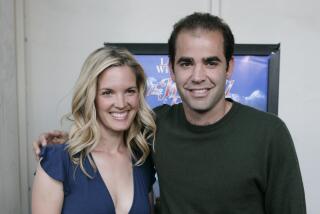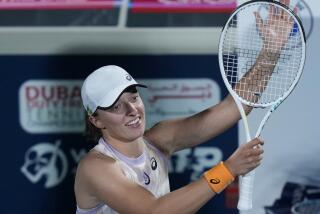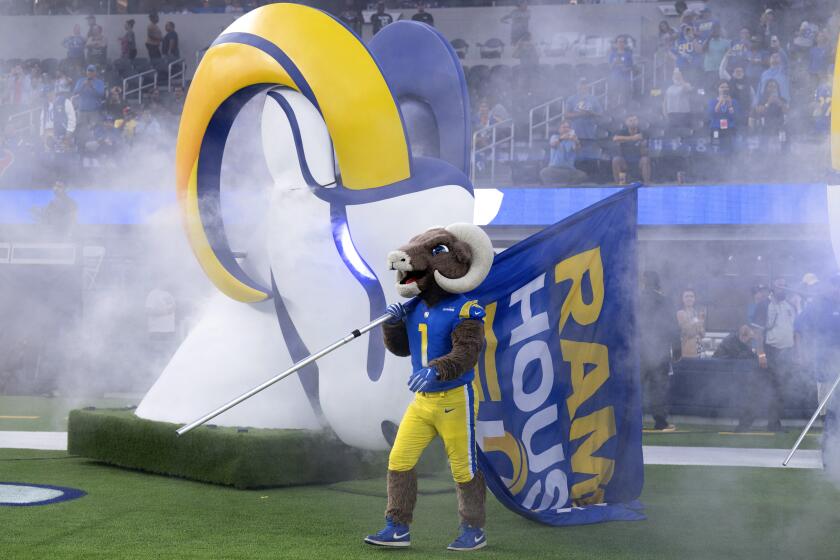Sampras Climbing Tennis Ladder : Ratings: After winning three tournaments, former Palos Verdes High player is ranked 14th.
Almost 19 now, Pete Sampras finds himself each morning facing one of the curses of maturity: the drudgery of shaving.
But even on those days when one of America’s future hopes to win Wimbledon decides to skip the razor, a rosy glow still peeks through the stubble.
Here, clearly, is a man on the brink who is in the pink.
Last week, Sampras showed how rosy his future is--and how slim the margin is between a hot young talent and a champion.
It happened in a match against Wimbledon champion Stefan Edberg, the semifinals of the Volvo Los Angeles Tennis Championships at UCLA Tennis Center. Edberg won it, 6-2, 6-7, 6-1, but Sampras left everyone, including Edberg--the world’s No. 2 player--impressed.
“He’s a very dangerous player,” Edberg said. “With time and matches, I think he’s going to be a top 10 player very soon. He’s got all the ingredients to be a very good player if he keeps working.”
Sampras showed off all the weapons in his arsenal in Saturday’s semifinal, a duel that matched up two of tennis’ premier serve-and-volley specialists: Sampras often aced a flatfooted Edberg, blasting his first serve consistently in the 115-m.p.h. range.
He also hung tough against Edberg’s high-kicking rocket serve, ripping a series of blistering backhand winners past the onrushing Swede.
Sampras hit more winners that afternoon than did Edberg.
The difference in the match was experience. For every brilliant shot Sampras hit, Edberg had an even better reply.
“I think I have all the shots I need,” Sampras said. “It’s just a matter of putting them all together at the same time.”
The way Sampras is playing, that time doesn’t seem very far away. He has had an outstanding year--winning three tournaments--and his world computer ranking has climbed to No. 14.
This week, Sampras was playing in the ATP Championship in Mason, Ohio--one of a series of hard-court tournaments leading up to the U.S. Open. He has now reached the semifinals of two consecutive tournaments, including the Players’ International in Toronto.
As a sophomore at Palos Verdes High, Sampras was unbeaten in 56 sets and captured the Southern Section CIF 4-A title. The following season he turned professional, almost as an afterthought.
In April of 1988, Sampras skipped four days of school and proceeded to knock off two top touring professionals--Ramesh Krishnan and Eliot Teltscher--in the Champions Cup at Indian Wells.
He quit the Palos Verdes High team, kept the check for $7,000, and said goodby to amateur days.
Sampras credits his fast start this year to a preseason conditioning regimen. He took on a new coach--Joe Brandi of the Nick Bollettieri Tennis Academy--who put him through a weightlifting and running program, in addition to five hours of tennis each day.
It paid immediate dividends. Sampras reached the quarterfinals in Sydney, losing to Mats Wilander, and the semifinals in Milan, where he lost to Ivan Lendl.
Then Sampras started going all the way. He broke into the Top 20 at the U.S. Pro Indoor Championships in Philadelphia in February, knocking off Tim Mayotte and Andre Agassi on his way to a final against eventual French Open champion Andres Gomez.
Once there, Sampras defeated Gomez in straight sets, 7-6, 7-5, 6-2, winning the same tournament where it all began two years before, when Sampras had battled through the qualifying draw as an amateur.
“The conditioning is the biggest factor,” Sampras said. “It’s carried me through the whole year to this point.”
The week before Wimbledon, Sampras won a grass-court tournament at Manchester, England.
Tennis experts believe that if Sampras can harness the thunder of his attacking game at Wimbledon, he can become this country’s best chance to win tennis’ biggest prize.
Wimbledon was Sampras’ biggest letdown of the year, however. He got an unlucky draw--grass-court expert Christo van Rensburg of South Africa--and was eliminated in the first round in three tough sets.
“I prepared well for Wimbledon,” Sampras said. “I just didn’t play well.”
He bounced back a week later, however, winning a tournament in Tokyo.
“I don’t think it’s realistic for me to win Wimbledon yet,” Sampras said. “I think I’ll play my best tennis in my mid-20s, so I have a lot more chances at it. I don’t want to put extra pressure on myself.”
That laid-back approach has been the hallmark of Sampras’ career--going back to age 14, when he switched from a two-handed backhand to improve his serve-and-volley game.
In doing so, Sampras was going against the grain of most junior players, who were developing as base-line counterpunchers.
Sampras took it a step further by seeking out competition against older, stronger players.
Instead of focusing on winning matches, he honed his aggressive game against the hard hitters, and along the way he learned the fine art of improvisation so vital to attacking players.
“I didn’t have a high ranking in juniors,” Sampras said. “I was playing to improve my game, and it’s really paying off right now. It was a move I made for the long run.”
The one-handed backhand--taught to Sampras by his first coach, pediatrician Peter Fischer--is also reaping rewards.
It improves Sampras’ range and gives him an array of spins--slice, flat or topspin--for all situations. It also helps Sampras charge the net quicker on his approach shot.
A six-foot, 180-pounder, Sampras seemingly has only one weakness--inside his own head. He admits his concentration lags at times.
“If I’m up a service break in the second set, sometimes I’m already looking ahead to shaking the guy’s hand after the match,” Sampras said. “I’ve got to constantly remind myself to concentrate on every point.”
When Sampras wins the mental battle with himself, his opponents often fall as well.
In last year’s U.S. Open, Sampras beat defending champion Wilander--a crafty base-liner--in a draining, five-set, second-round match played in sweltering humidity.
Sampras’ concentration never flagged in that one. At other times. . . .
In the semifinals at Toronto this year, Sampras faced longtime nemesis Michael Chang, whom he has been battling since both were 10.
Sampras won a tiebreaker in the second set to pull even, but eased up on Chang in the third and lost the match, 3-6, 7-6, 5-7.
“I should have won that one, but I let it slip away,” Sampras said. “That’s one reason I haven’t had too much success against Chang at the pro level. He’s not going to give you a match . . . you have to earn it. But I’m sure we’re going to be going at it many more times before it’s over.”
Sampras also lost this week to Chang, 7-5, 6-4, in the ATP Championship.
Edberg didn’t seem to think Sampras’ concentration lapses were a serious obstacle.
“It happens to everybody,” Edberg said. “It’s just a matter of learning, being out there and playing matches.”
While Sampras continues his lessons, he represents part of the changing of the guard--the youth movement that includes Chang, Agassi and others--in American men’s tennis.
To set up that Toronto meeting with Chang, Sampras defeated veteran John McEnroe, 7-6, 4-6, 6-3, in the quarterfinals.
“That was a thrill,” Sampras said. “At first I was a little nervous. For the last 10 years, I’ve looked up to him. At first, I was playing John McEnroe--the legend. Then I started playing the ball.”
Right now, Sampras’ computer ranking is only a rung below McEnroe’s 13th.
For Sampras, that’s only a step away from putting legends behind him, and starting some of his own.
More to Read
Go beyond the scoreboard
Get the latest on L.A.'s teams in the daily Sports Report newsletter.
You may occasionally receive promotional content from the Los Angeles Times.










